Fresh, Beautiful, Convenient
Growing your kitchen herbs in containers is convenient, cost-effective, and suits gardens of any size. In addition, Garden herbs, aromatic, beautiful, and useful, are ideally suited plants for your kitchen garden! Also, with their smaller root systems, they grow productively in small spaces.
Convenience is insured by the fact that as long as their growing requirements are similar, you can even group several different herbs together in the same container.
We prize herbs for freshness, and no food products are fresher than those grown close to the kitchen. Fresh herbs, like leafy green vegetables, contain large amounts of vitamins A, C, and K. Many of them also contain large amounts of polyphenols, which have antioxidant and anti-inflammatory capabilities.
“Much virtue in herbs, little in men”
-Benjamin Franklin
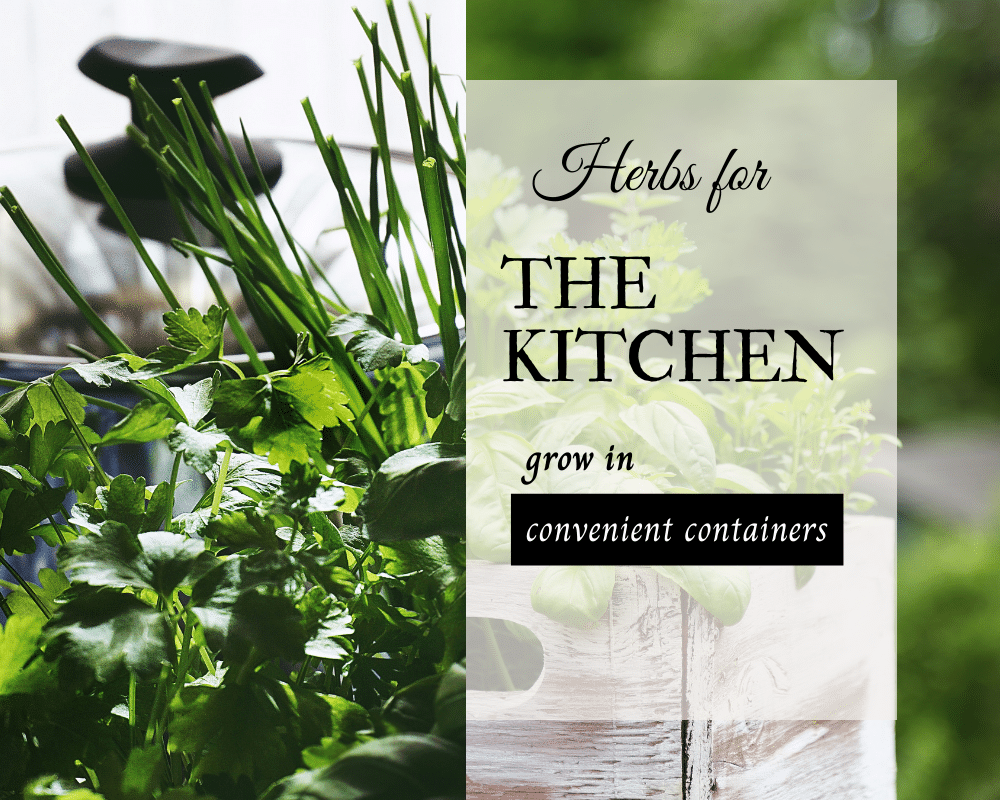
Benjamin Franklin was sometimes a little critical of us humans, but he did appreciate good cooking. We have letters today that he wrote to Deborah, his wife, while he was in Europe on the new nation’s business.
She, in turn, sent shipments of roasts, mince pies, and American crops for his meals in Europe.
Perhaps, after all, we are what we eat!
Our Collective Olfactory Memory is Long…
Herbs are the simplest of plants. For centuries, people have picked them in the wild for the cooking pot or home remedies. As long as people have hunted and foraged for something to eat, we have been bringing herbs home to the hearth. We have found them inside Egyptian sarcophagi. People have used herbs to eat better, cure diseases, and heal wounds. Humans have considered them capable of carrying spiritual messages between us and deities.
“Herbs are the friend of the physician
and the pride of cooks”
-Charlemagne
For more information on growing herbs in containers read this.
Kitchen Herbs in Containers-an Undemanding Garden
Herbs require little space. You can grow some for cooking in a corner beside the kitchen door or on the patio. Many cooks in every culture have found a way to grow what is needed. Here is how it works.

We rented two of these Narrowboats on the English canal system. This is where we saw the most creative herb gardens. People vacation on these canal boats, and others live aboard. See the little flower and herb garden on the roof of the first boat. We saw hundreds of these growing just above the galley.
A small space is no impediment to a handy herb garden.
My Kitchen Herb Garden
I am a lifelong gardener, a volunteer Master Gardener in my community (we all work through our state agricultural universities) a descendant of gardeners, and as soon as this is done, I’ll pick some basil for pesto.
In my South Florida Zone 10 subtropical garden, I grow most herbs in containers. In winter, in our cooler and dry season, growing herbs is easy. But in our hot, wet, humid summers, it is a little more challenging. However, we don’t stop cooking and eating in summer, and we find that a space under a palm tree near the kitchen is a perfect place to keep herbs in containers. We move them into the sun when needed and under the tree to shelter from the most oppressive sun and rain. It works well.
What You Need to Grow Your Kitchen Herbs in Containers
A reasonably sunny spot, one or more containers for them to grow in, a convenient location to pick them as you need them, a source of water, and a good quality potting soil to grow them in.
Growing Herbs Together
Whenever the herbs have the same growing requirements, you can grow them together in one pot. How to combine them? Think first about those herbs you like to cook with. Grow plenty of them before experimenting with something new.
Ask yourself, where did this plant originate? That will tell you what conditions the plant needs.
Mediterranean Herbs
Think of sunny blue skies, rocky soil, and no clouds above. You can group these herbs together in one planter. Water after the top inch of soil is fully dry. Herbs on this list include:
- Lavender
- Rosemary
- Oregano
- Thyme
Below are some examples.
Lavender
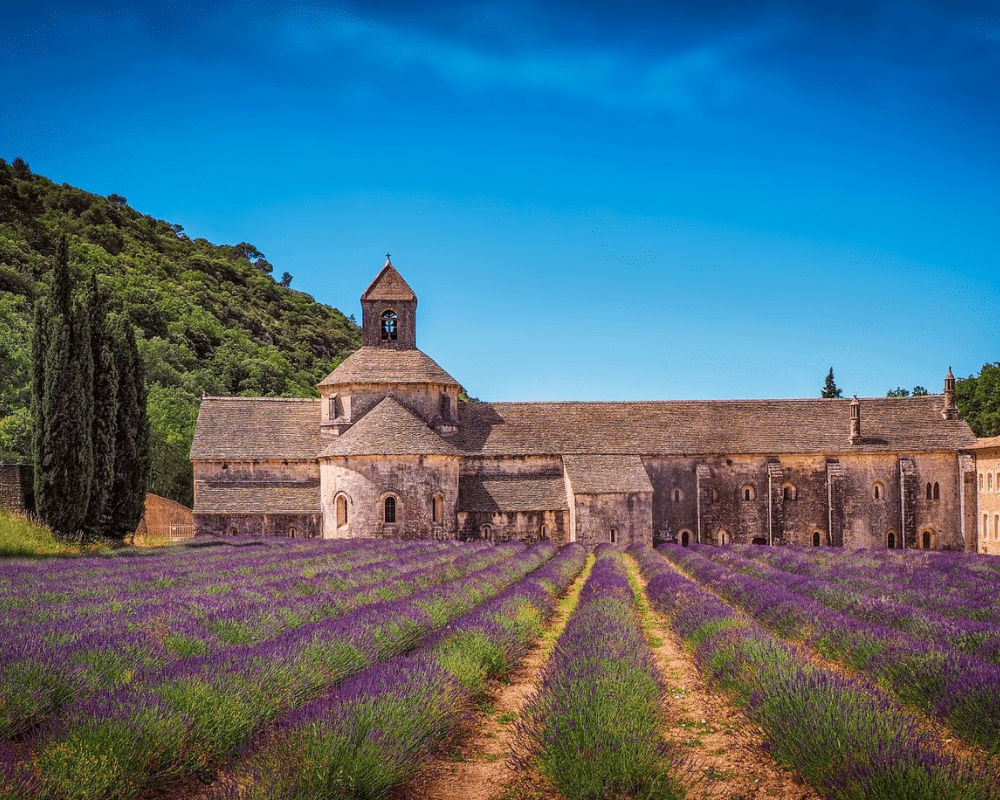
Rosemary
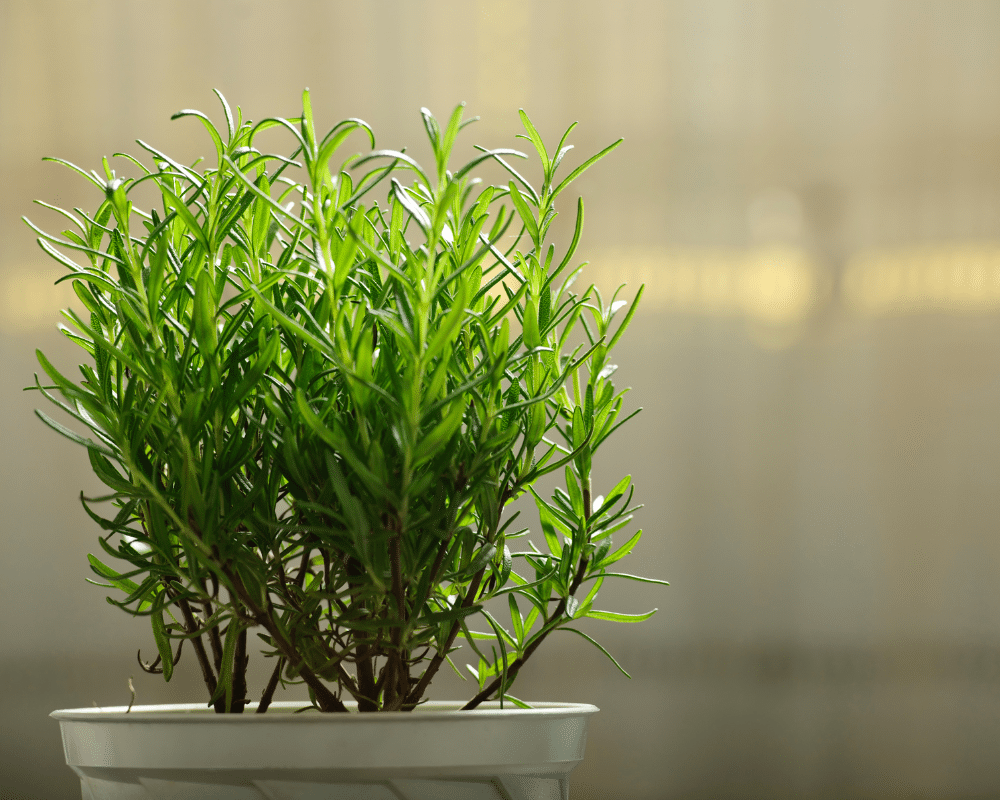
Rosemary, richly aromatic, is probably the queen herb of Mediterranean hillsides. It is happy in full sun and in soil that dries out between rainstorms.
Combine it with any form of oregano, sage, and lavender, and you will have a container of live herbs ready for flavor.
For more about growing and using rosemary.
Moisture Loving Herbs in Containers
Some herbs perform best with soil that drains well but remains moist every day. Never wet but steadily moist, you can grow these together in another container. The list includes:
- Parsley
- Cilantro
- Basil
- Dill
Here are some examples to consider for your moist soil container.
Basil
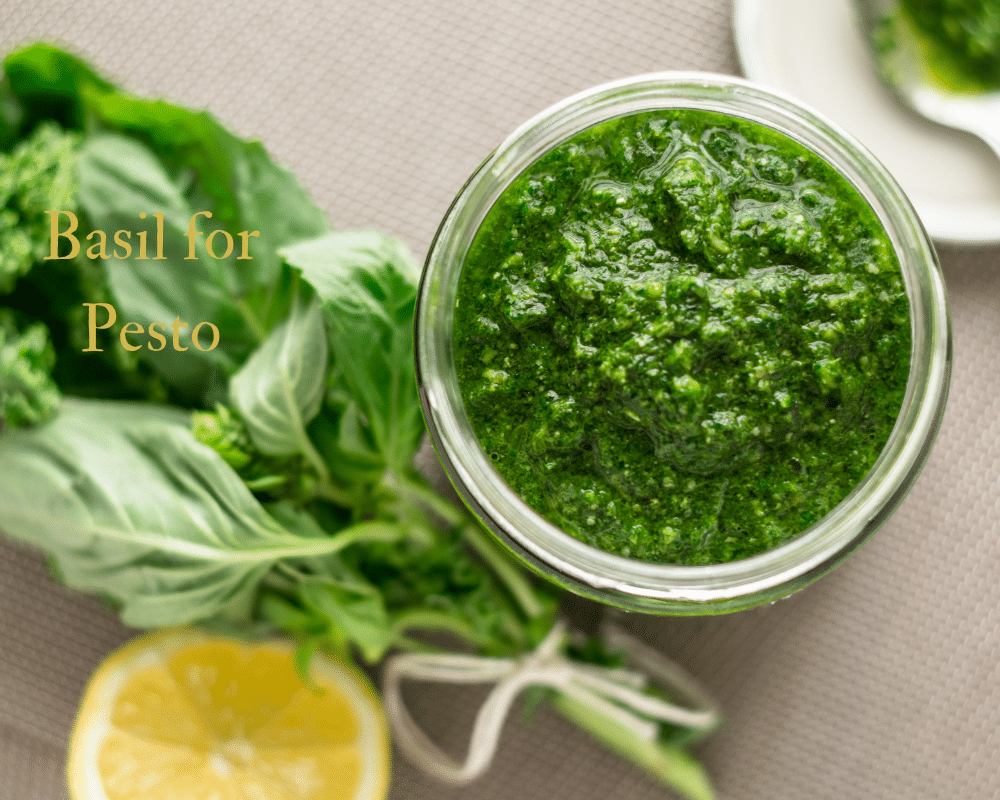
Compare those with basil, the herb you need for pesto and any tomato dish. Basil will thrive in the same full sun, but like parsley, dill, and cilantro, it performs best in soil that drains thoroughly but remains consistently moist.
They will all grow in the same space, but the basil, dill, and cilantro will have a separate pot that you can water more frequently.
For more information on Basil, including a link to my favorite pesto recipe, go here.
Here is a Tasty, Useful Herb that is Best by Itself
Mint
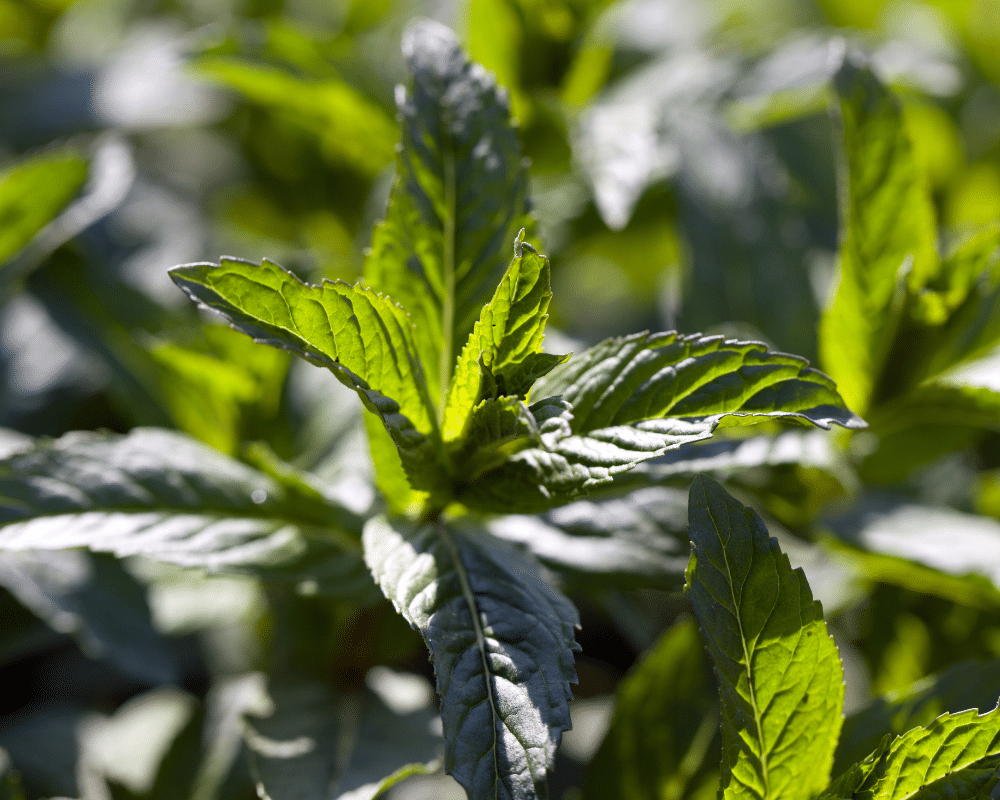
What about mint? Delicious and aromatic, useful in dishes both savory and sweet, as well as beverages, it is the bully of the garden. Corral it in its own container, where it will be ready for tea, desserts, and anything else you need it for.
For six things to know about mint read this.
Why So Many of Us Grow Our Own Herbs
Here is why I grow my own herbs instead of buying the little limp packages in the vegetable aisle.
- Gratification is almost instant, as harvesting starts early. (You can take about 1/3 of the plant mass at a time.)
- They are among the very easiest plants to grow. (This includes annual, biennial, and perennial herbs.) They are all easy to handle.
- Herbs have modest nutritional requirements.
- Good harvests of herbs can come from small spaces. (For a few uses, such as pesto, I add an extra plant to ensure I always have enough, and I like to plant a large rosemary shrub for rosemary wood skewers, which is delicious for lamb.)
- When I dry some of my own herbs for cooking, I find the flavor richer than any of the commercial brands. (Dry some oregano and test it yourself, you’ll be pleasantly surprised.)
- Nothing ever tastes like fresh herbs added late in the cooking process. Try adding some as you finish the scrambled eggs.)
How to Grow Your Own Container Herb Garden
On this site, I have included a piece on each of the herbs I find useful. This comes from my own hands-on experience in various climate zones and from the training we Master Gardeners are given from our state agricultural school. Here is an example. All About Parsley.
How to Plant Herbs in Containers
You can get your herbs from cuttings of mature plants (see my individual plant articles) and from the small starter plants you find at the garden center. Some herbs are easier than others to start from seed.
Take your rooted starter plant, usually in a 4″ or even smaller pot. Tap and gently squeeze the pot to release the little plant without pulling it. Gently loosen the small white roots. Place it in a hole that allows the plant to be even with the soil, just as it was potted. Water the plant; I like to begin with a slow-release fertilizer in the hole. Space your plants as the label specifies. Always measure plant distances from the middle of the hole. I find it helpful to set the pots where I want them and mark the spots before digging.
How to Choose the Best Soil
When choosing soil for your container garden, always be aware that a container is not a normal place for a plant to live. In container gardening, we eliminate the plant’s ability to reach for nutrients and water. We need to supplement the plant’s food source.
This is my research on buying potting soil; it includes everything I find important. I hope it helps you.
How to Choose the Best Containers
Here are features to keep in mind in selecting planting containers.
- The container needs holes for drainage. Use trays underneath so you can see the water as it drains, and protect your floor if you are gardening on a porch or patio. Small pebbles in the floor tray help you see the water and ensure drainage.
- The container should be one to four inches larger than the planting mass.
- Container materials are a matter of personal taste but don’t overlook the effect on the plant material.
- Plastic is light, easy to move, inexpensive, and holds water the longest.
- Clay has a rustic charm and is heavier and more porous. In our tropical climate, we do not use them in full sun as the soil dries speedily.
- Ceramic, heavy to lift (a benefit in storms), and not porous.
- Metal containers have a certain countrified charm but can get hot.
How To Prune And Harvest Your Herbs And Relish Every Leaf
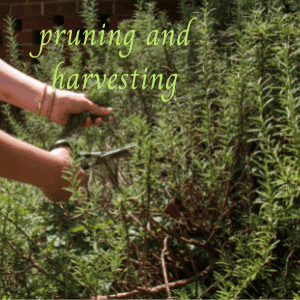
The way that we prune and harvest and our timing in doing so can extend the useful lives of these herbs and the flavors we get from them.
Pruning from the parent plant can even give us a succession of new plants to keep the party going.
How To Harvest And Use Your Fresh Herbs
You can begin to harvest when the plant is large enough to preserve growth or when the plant is 6-8″ high. During the growing season, harvest until the first frost appears. You can take cuttings and grow most herbs indoors. Here is more information on growing herbs indoors.
Use The Right Technique For Different Herbs
Herbs can be subdivided in different ways that affect how we handle them.
Annual, Biannual, And Perennial
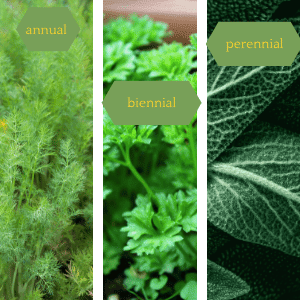
Annual herbs are those that complete their lifecycle in one season. They go from seed to seed in one year. The seeds will regrow.
Annual Herbs
Good examples are:
- Basil: warm weather, fragrant herb. If you love pesto, plant lots.
- Chervil: delicate flavor in the parsley family, a favorite in French dishes.
- Cilantro/Coriander: lemony with a hint of pepper in the parsley family.
- Dill: unique pungent flavor with a hint of anise.
- Summer Savory: widely compatible, like thyme.
Biennial Herbs
These are herbs that grow leaves, stems, and roots in the first year. In the second, after winter dormancy, they flower, produce seeds, and die. It is a good idea to plant one every year; the flavor and output can change each year.
- Parsley: versatile herb we have used for 2000 years. High in vitamins A, C & K
Perennial Herbs
The original plant grows or comes back year after year and continually increases in size.
- Bay: leaves are produced by the evergreen sweet bay tree.
- Chives: provide delicate onion-like flavor and are usually used raw.
- Lavender: angustifolia, is the sweeter variety and does appear in cooking.
- Marjoram: related to oregano. Use it for a milder and sweeter flavor.
- Mint: there are many varieties, each producing a different fruity, aromatic flavor.
- Oregano: aromatic herb with antioxidant benefits.
- Rosemary: valued for a sweet and resinous flavor.
- Tarragon: identified by its thin leaves, it is a favorite in French cooking.
- Thyme: use the tiny leaves for their earthy, minty savory flavor.
- Winter Savory: think of it as a piney cross between mint and thyme.
Soft Or Woody Growth Habit
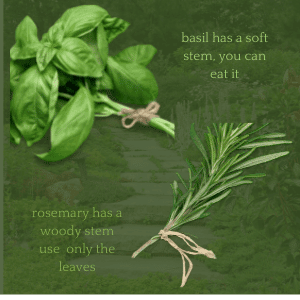
Basil, coriander, and parsley are soft herbs and can be eaten raw.
Rosemary, sage, and thyme are plants with foliage that grows on a woody stem. It gets woodier over time. Add these while cooking; they will give flavor without being eaten.
Cut The Plant To Suit Your Intentions
Cut Herbs For The Kitchen

To shape the plant or cut for the kitchen, cut just above a node (where the leaves join the stem). The plant will use the growth hormone in the node to grow more foliage.
Cut Herbs To Make A New Plant
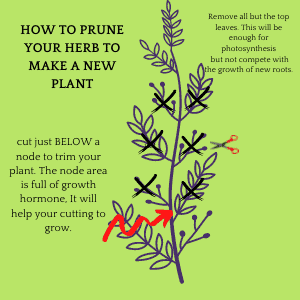
If taking a cutting to make a new plant, do this. Cut just below a node, and remove all the lower foliage. You can root most herbs in water. It should take about three weeks for new white roots to reach over an inch in length. You can plant your new herb at this point.
Using Your Herbs In The Kitchen To Cook With
Herbs, both fresh and dried, will add flavor to your cooking without preservatives, salt, or fat. You can combine them as you wish to flavor your meals, and you can use some herbs in combination to substitute for others.
Fresh Versus Dried or frozen Herbs
The most complex and delicate flavors come from fresh herbs. These are used raw or cooked and are usually put into the cooking pot later in the process. If your recipe calls for dried herbs, use about three times the fresh quantity. Whole herb leaves can be used earlier and removed for service. You can cut and chiffonade the leaves as late additions or garnishes.
Dried herbs are usually more densely flavored and use, less. They are used in cooking and earlier in the process. An alternative to dried herbs is to freeze them using a little oil or water.
Condiments To Make With Herbs
Try these tasty and simple ideas as a way to preserve and use your herbs.
Summary,
A Few Notes on Location
Most herbs prefer full sun, their water needs differ, and it is good to fertilize but not too much as it can create big but flavorless plants.
Convenience is important. Plant as closely as possible to where you cook. If you can get your fresh herbs quickly, you will use them more.
References You Can Use
Culinary Herbs-What I have learned as a Master Gardener, herb grower, and cook. It includes links to other related subjects both on my website and to other sources I use.
Integrated Pest Management -USDA
Integrated Pest Management University of Florida-This is the IPM information for my climate from my state university. Wherever you garden, your local agricultural University will teach it to you.
How to know your first and last frost dates. This is important to herb health as pruning and harvesting encourage new growth, which can be susceptible to freeze damage.
